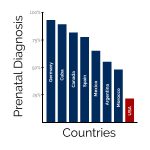It is possible to detect most congenital heart defects during pregnancy at the 20-week diagnostic ultrasound. In fact, in countries from the United Kingdom to Cuba, over 85% of all congenital heart defects are diagnosed prenatally.
Yet in the United States, only 15% of babies born with CHDs are diagnosed during pregnancy.
Significance of Postnatal Diagnosis
 The effects of postnatal diagnosis can be significant, ranging from substantially increased costs of emergency treatment, suboptimal surgical repairs, and even preventable deaths.
The effects of postnatal diagnosis can be significant, ranging from substantially increased costs of emergency treatment, suboptimal surgical repairs, and even preventable deaths.
The United States lags behind its industrialized counterparts and even developing countries with regard to prenatal detection of CHDs. The reasons for this abysmal failure in the delivery of maternal and fetal healthcare are many, ranging from insufficient training of ultrasound technicians to the belief that prenatal diagnosis does not affect outcomes in the aggregate.
However, most mothers would prefer to know whether their child has a major birth defect during pregnancy, regardless of whether he is 1 in a 100 diagnosed with such a condition.
Prenatal Diagnostic Ultrasound Checklist
 If you are pregnant and would like the best chance of knowing whether your baby has a congenital heart defect, print out the below questionnaire and take it with you to your 20-week diagnostic ultrasound for the doctor or technician to fill out (and arrange that a doctor conduct the ultrasound him/herself, as opposed to a tech, if at all possible).
If you are pregnant and would like the best chance of knowing whether your baby has a congenital heart defect, print out the below questionnaire and take it with you to your 20-week diagnostic ultrasound for the doctor or technician to fill out (and arrange that a doctor conduct the ultrasound him/herself, as opposed to a tech, if at all possible).
Additional Materials
ISUOG Practice Guidelines: Sonographic Screening Examination of the Fetal Heart
Prenatal Screening for Major Congenital Heart Disease: Assessing Performance by Combining National Cardiac Audit with Maternity Data